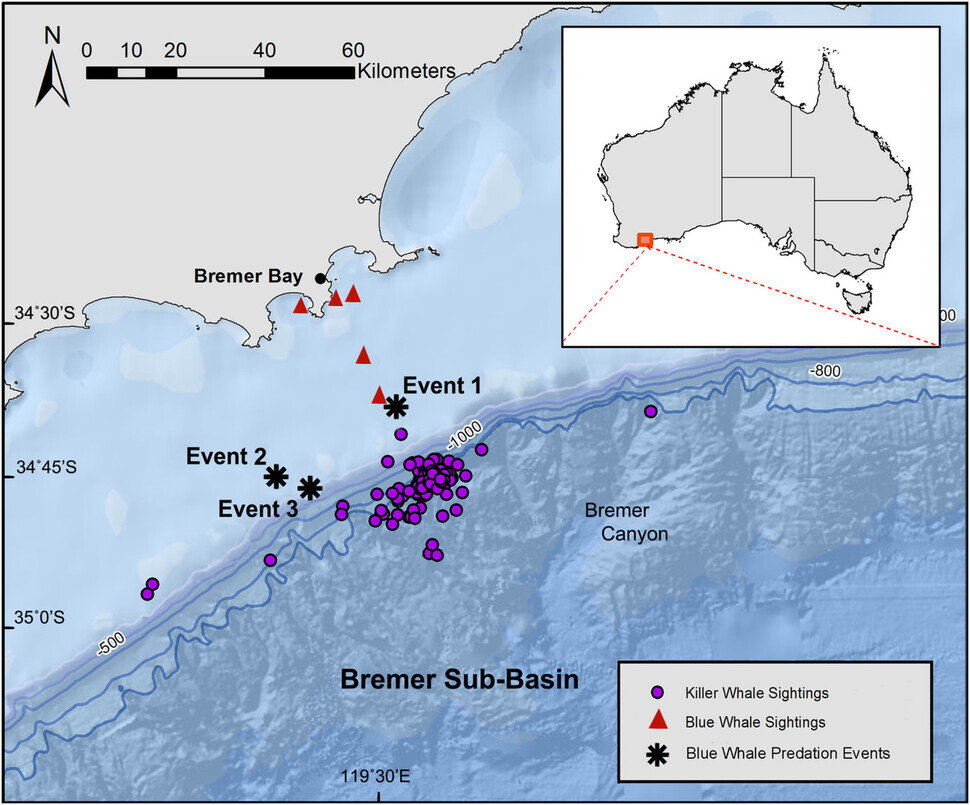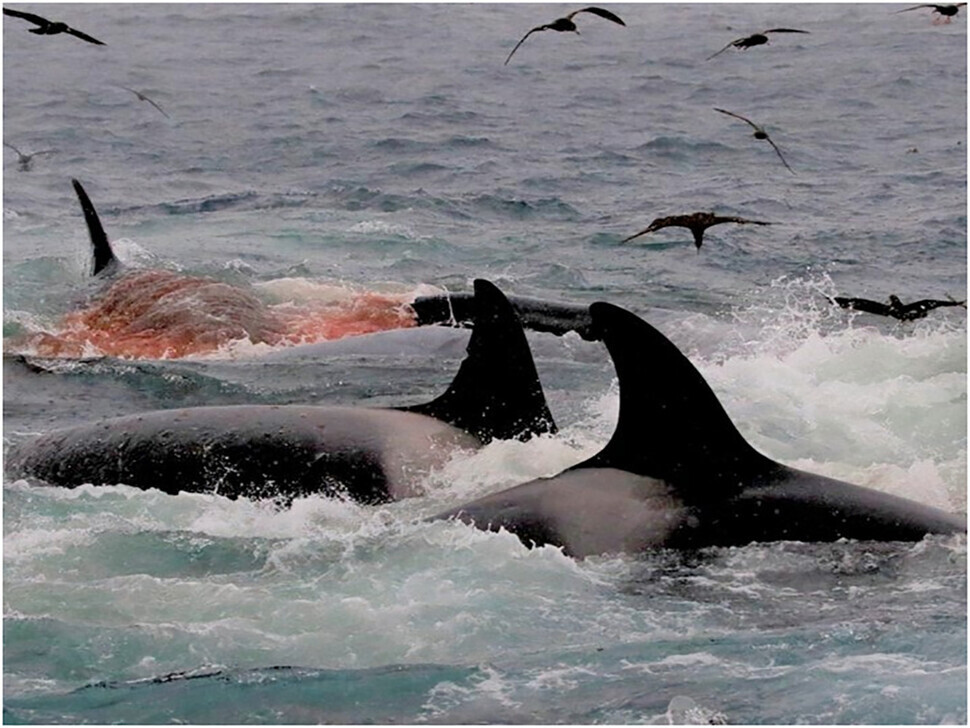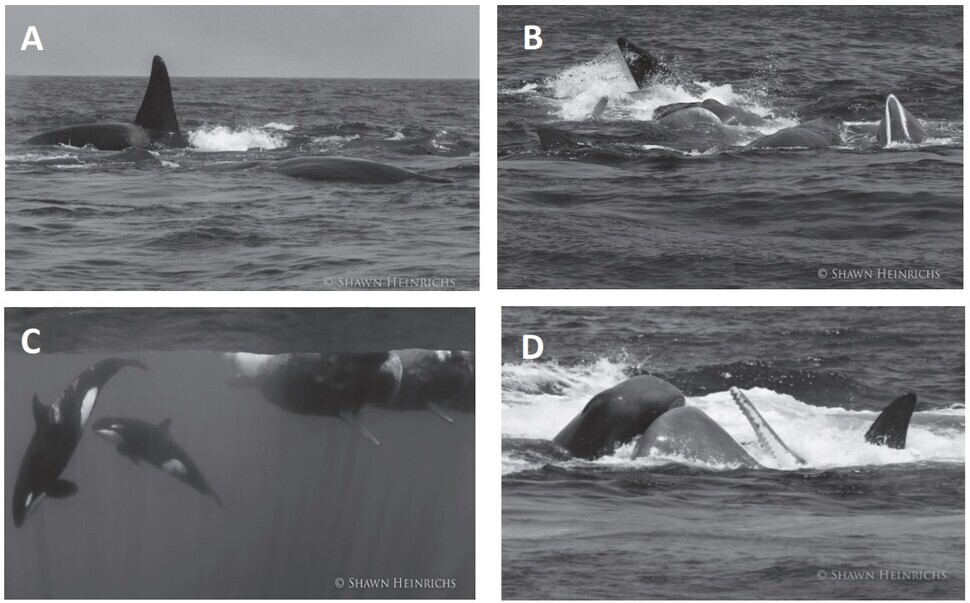hankyoreh
Links to other country sites 다른 나라 사이트 링크
Killer whales killing whales: Orcas seen hunting blue whales for first time

For the first time, orcas have been observed hunting and partially consuming the blue whale, the largest of the baleen whales and a species over twice their size.
Known commonly as killer whales, orcas are a species of toothed whale found throughout the world’s oceans. They are apex predators that hunt in packs like wolves.
In an article published in the most recent edition of the science journal Marine Mammal Science, John Totterdell of the Cetacean Research Centre in Western Australia, and others reported three instances of orcas killing and consuming blue whales. The cases were witnessed in March and April 2019 and March 2021 along the coast of Bremer Bay in southwestern Australia.

The third instance, in particular, has been drawing attention, as it involved the hunting and consumption of a healthy adult blue whale, in contrast with the two previous attacks targeting juvenile whales. While the Western Australian blue whales are relatively smaller, they still measure 18 to 21 meters in length, making them over twice as large as orcas, which reach as long as nine meters.
“Although [orcas] are known to prey on the calves of large whales, there is ongoing debate as to whether they can take healthy adults of the largest species,” the researchers explained.
Explaining the orcas’ strategy, the researchers said that around 50 of them attacked a blue whale while it was traveling through the waters, with groups of several animals each taking turns pursuing and biting the larger whale and dragging it under the water to drown it.

Corresponding author Robert Pitman, a marine ecologist at Oregon State University, said in an interview with National Geographic that this was “the biggest predation event on this planet: the biggest apex predator taking down the biggest prey.”
Social animals with long lifespans, orcas maintain matriarchal societies centering on grandmothers, who harbor years of experience and wisdom. Traveling in groups along the same lines as wolves, they communicate their hunting strategy through noises — preying on nearly every kind of large animal in the oceans, from salmon to great white sharks and sperm whales.

Among other species of whales, orcas target gray whale calves, in particular, sometimes hunting them while they are with their mother. Some have claimed that orca predation influences the migration paths and lifestyles of sperm whales and other large whales.
The researchers predicted that the orca hunting would not imperil the blue whale’s recovery from endangered status. Instead, they said it represents the return of a hunting practice from the pre-whaling era, when blue whales were more abundant.
The largest animals currently in existence on Earth, blue whales have been considered an endangered species since the 1900s due to overhunting. Populations have been gradually recovering since the 1960s, and in 2018 the International Union for Conservation of Nature classified them as “endangered” with an estimated 5,000 to 15,000 individuals scattered across the globe.
By Cho Hong-sup, environment correspondent

Editorial・opinion
![[Column] Season 2 of special prosecutor probe may be coming to Korea soon [Column] Season 2 of special prosecutor probe may be coming to Korea soon](https://flexible.img.hani.co.kr/flexible/normal/500/300/imgdb/original/2024/0426/3317141030699447.jpg) [Column] Season 2 of special prosecutor probe may be coming to Korea soon
[Column] Season 2 of special prosecutor probe may be coming to Korea soon![[Column] Park Geun-hye déjà vu in Yoon Suk-yeol [Column] Park Geun-hye déjà vu in Yoon Suk-yeol](https://flexible.img.hani.co.kr/flexible/normal/500/300/imgdb/original/2024/0424/651713945113788.jpg) [Column] Park Geun-hye déjà vu in Yoon Suk-yeol
[Column] Park Geun-hye déjà vu in Yoon Suk-yeol- [Editorial] New weight of N. Korea’s nuclear threats makes dialogue all the more urgent
- [Guest essay] The real reason Korea’s new right wants to dub Rhee a founding father
- [Column] ‘Choson’: Is it time we start referring to N. Korea in its own terms?
- [Editorial] Japan’s rewriting of history with Korea has gone too far
- [Column] The president’s questionable capacity for dialogue
- [Column] Are chaebol firms just pizza pies for families to divvy up as they please?
- [Column] Has Korea, too, crossed the Rubicon on China?
- [Correspondent’s column] In Japan’s alliance with US, echoes of its past alliances with UK
Most viewed articles
- 1Division commander ordered troops to enter raging flood waters before Marine died, survivor says
- 2‘We must say no’: Seoul defense chief on Korean, USFK involvement in hypothetical Taiwan crisis
- 3Is N. Korea threatening to test nukes in response to possible new US-led sanctions body?
- 4No good, very bad game for Korea puts it out of Olympics for first time since 1988
- 5Korea’s 1.3% growth in Q1 signals ‘textbook’ return to growth, says government
- 6US overtakes China as Korea’s top export market, prompting trade sanction jitters
- 7[Column] Has Korea, too, crossed the Rubicon on China?
- 8[Column] ‘Choson’: Is it time we start referring to N. Korea in its own terms?
- 9Will NewJeans end up collateral damage in internal feud at K-pop juggernaut Hybe?
- 10Samsung subcontractor worker commits suicide from work stress